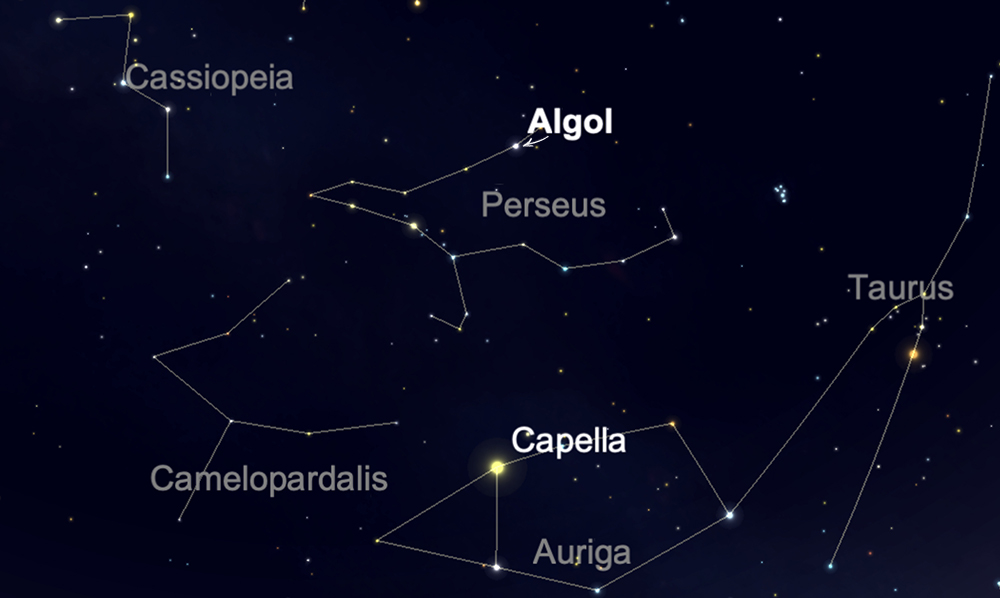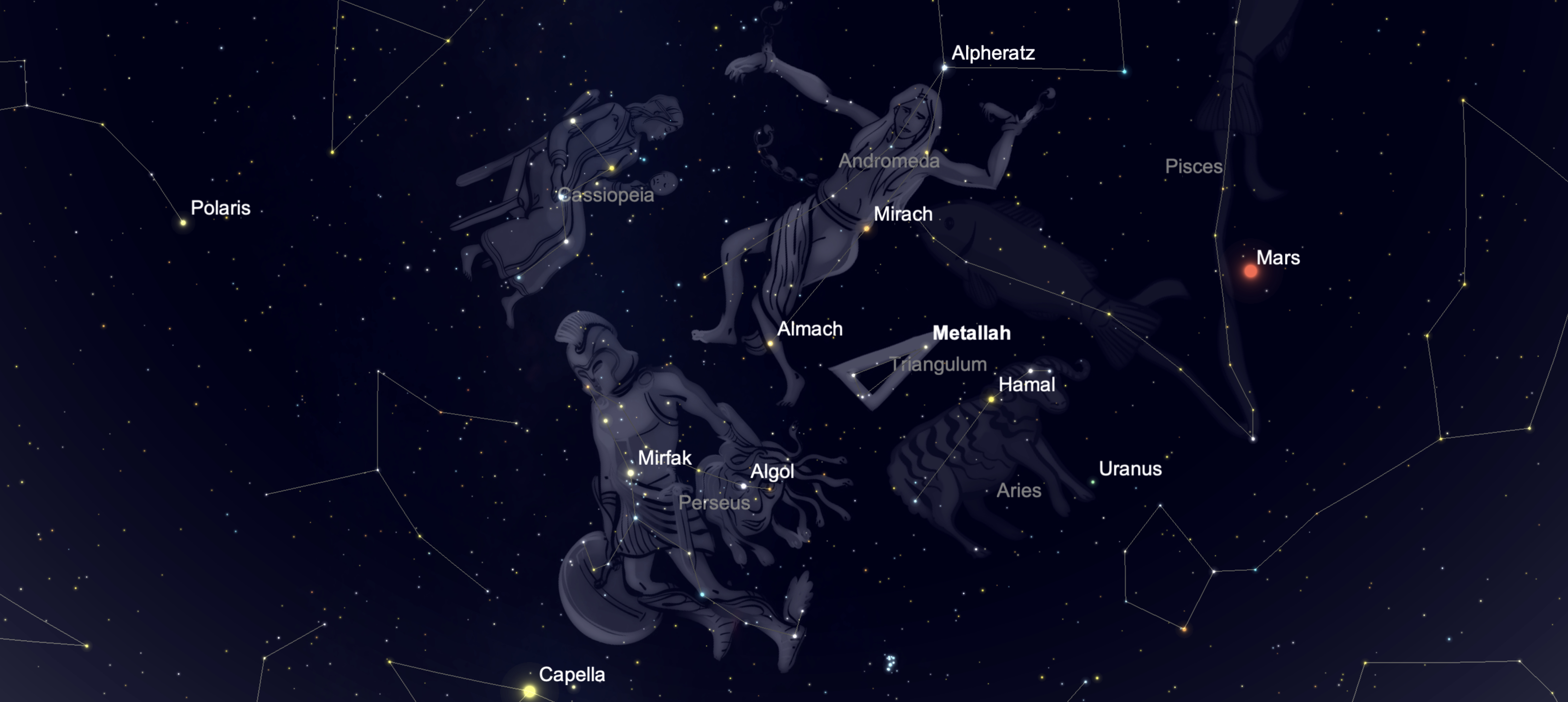
A lovely constellation that straddles the Milky Way is Perseus, the hero, which is visible in the northern skies from July to March. Its stars arc from Capella, in the constellation Auriga, to the "W" of Cassiopeia. But there is one star here that is really quite special.
According to a legend, late in the 18th century, a famous Parisian astronomer would stand on one of the Seine bridges on nights when the variable star Algol was in eclipse, to point out this remarkable phenomenon to passersby.
Today, more than 40,000 Algol minima later, the periodic brightness changes of this star remain a fascinating sight to the stargazer who knows when to look and what to look for.
Related: Ancient Egyptian calendar reveals earliest record of 'Demon Star'
Brightness fluctuations
For someone who observes with the unaided eye, Algol (also known as the Demon Star) is quite possibly the most interesting star in the fall and winter skies, if they know when to look for its brightness changes. It is a famous prototype variable star, though it is not intrinsically one; in other words, it does not fluctuate in brightness on its own. Rather, its light changes result from the eclipse of one binary-star component by another, because the two companion stars' orbital plane lies nearly in our line of sight.
The two components are about the same size but unequal in luminosity, or brightness. The slightly smaller, blue star is brighter than its orange companion, and when it passes behind the latter, the total light of the system fades greatly. But when the bright star goes in front of the dim one, the light drop is much less.
The cycle from one eclipse to another has a period of about 2 days, 20 hours, 48.8 minutes and a visual magnitude range of about +2.0 to +3.3. (Magnitude is a measure of brightness). Algol appears only one-third as bright as it would normally appear during the peak of the eclipse. Most of the time Algol's light appears constant, but for about four hours its light varies noticeably.
Get the Space.com Newsletter
Breaking space news, the latest updates on rocket launches, skywatching events and more!

At its maximum light, Algol is about equal in luster to the nearby star Gamma Andromedae, a triple-star system in the Andromeda constellation also known as Almach. At minimum, it is slightly brighter than another nearby binary star system, Alpha Trianguli. Its name derives from Ra's al-Ghul, Arabic for "the demon's head," according to the late star-name expert George A. Davis, Jr. And, in fact, our word "ghoul" comes from the same Arabic word. It is also called Metallah (or Mothallah), meaning "head of the triangle."
The light variations recognizable by the naked eye are confined to less than 10 hours of each cycle. During this interval Algol fades gradually to minimum light, then gradually returns to full brightness. Most of this change occurs within the three hours before and three hours after the time of maximum eclipse.
Two eclipses this week
For North American viewers, the two most favorable occasions this month for watching an Algol eclipse will come during the late-night hours of Friday, Oct. 23, and again during the evening hours of Monday, Oct. 26. The former date is particularly suitable for much of the continent, maximum eclipse occurring just after midnight Eastern Daylight Time (11:02 p.m. CDT; 9:02 p.m. PDT; 0402 GMT). From most locations, Algol will appear to soar high above the eastern horizon.
The Algol eclipse on Oct. 26 will be best seen from the eastern and middle parts of the United States and Canada since its midpoint is due at 8:50 p.m. EDT (0050 GMT on Oct. 27) with Algol situated about halfway up in the northeast sky. This is about one hour after evening twilight ends for the Central time zone, and therefore observers should begin their watch as soon as the sky becomes dark. Farther west, Algol will be lower in the sky; the Mountain and Pacific time zones will either still be in twilight or it will be right around sunset, so only the gradual increase in brightness (after it gets sufficiently dark) will be observable.
Two hours before the predicted minimum, start checking Algol's brightness. If you are observing casually, a look every half hour is sufficient; if you are trying to determine the time of mid-eclipse, 10-minute intervals are better. Algol is at minimum light for about 20 minutes — as the large, dim star passes across the smaller, brighter one — then it gradually returns to normal.
Algol brightens and fades almost like clockwork, but nonetheless, is still subject to small, complex changes which are of considerable interest to astronomers.
The legend of the "winking star"
In the mythological figure of Perseus — the son of Zeus and the mortal Danaë — Algol marks the head of the Gorgon Medusa, a hideous creature with a form of naturally curly hair — snakes. Anyone who gazed at her immediately turned into stone. Perseus' mission was to behead Medusa and bring the head back to the island of Seriphus as a wedding gift. However, to avoid being turned to stone as he aimed his sword, he looked at the reflection of the sleeping Gorgon in his highly polished shield and beheaded her.
Talk about a "rocky" relationship!
Later, when flying over the seacoast of Ethiopia with his winged sandals, he noticed the sea monster (Cetus) approaching the beautiful chained princess, Andromeda, and dispatched the monster.
Some believe Algol is so called because it marked one of Medusa's eyes, which seemed to "wink" every 2.867 days. Thus, its name seems to suggest that the medieval Arabs were aware of its marked changes in brightness. In 1782, amateur astronomer John Goodricke was the first to realize that this star was really a pair of stars orbiting a common center of gravity and that when the dimmer of the two crossed in front of the other, the light from Algol appeared to fade. Because the entire eclipse takes 9 hours and 40 minutes from start to finish, the entire performance can be seen in a single night when the timing is right, such as will be the case on Friday night from coast to coast.
Should you be blessed with clear skies, enjoy this "eye-catching" performance.
Joe Rao serves as an instructor and guest lecturer at New York's Hayden Planetarium. He writes about astronomy for Natural History magazine, the Farmers' Almanac and other publications. Follow us on Twitter @Spacedotcom and on Facebook.
Join our Space Forums to keep talking space on the latest missions, night sky and more! And if you have a news tip, correction or comment, let us know at: community@space.com.

Joe Rao is Space.com's skywatching columnist, as well as a veteran meteorologist and eclipse chaser who also serves as an instructor and guest lecturer at New York's Hayden Planetarium. He writes about astronomy for Natural History magazine, Sky & Telescope and other publications. Joe is an 8-time Emmy-nominated meteorologist who served the Putnam Valley region of New York for over 21 years. You can find him on Twitter and YouTube tracking lunar and solar eclipses, meteor showers and more. To find out Joe's latest project, visit him on Twitter.









